Storage
Originally written February 1, 2006 | Last updated
October 26, 2016
EAR CORN STORAGE - CORN CRIBS

The safe level for ear corn in the crib is higher than for shelled corn because air passes through to remove heat and to dry the corn. In northern corn growing areas, the upper limit in narrow cribs (4 1/2 feet) is about 25% moisture in the grain. If late fall and winter are so damp that grain does not dry, spoilage will begin with the onset of warm weather in the spring. In the central Corn Belt where cribs are wider in order to handle higher yields, the safe limit is about 20%. Corn should be down to 18.5% by March 1 to avoid spoilage with the onset of warm weather.
-
Narrow cribs: 5-6 ft width - moisture % no higher than
22-23% -
Wide cribs: 7-8 ft width - moisture % no higher than
20-22%
-
Recommended crib width is narrower in northerly areas of
the CORN BELT
|
HIGH MOISTURE CORN (HMC)
-
Estimating the Value of Wet Ear Corn--A Suggested Starting Point
UWEX Bulletin A3410
-
Usually harvested at 28-32% kernel moisture
-
Equivalent Price/Ton of High Moisture
Ear or
Shelled Corn
vs Price per Dry Bushel: conversion tables for converting wet ear corn
and wet shelled corn to its dry corn price equivalent. Developed by Jeff
Key, Winnebago County and Gary Frank, Center for Dairy Profitability
|
Advantages of HMEC over HMSC
-
Can harvest 15-20% more feed/acre with HMEC than with
HMSC
-
Milk production/lb of feed is slightly better for HMEC
-
Cows don't go off feed as often with HMEC
|
Advantages of HMC over conventional harvesting
-
No Drying Costs
-
Earlier harvest
-
Spreads work load
-
Reduces harvest losses
-
HMC is more palatable than dry corn
Handling and processing of HMC for good packing and
fermentation
-
95% of the kernels should be cracked or broken
-
Cob pieces shouldn't be larger than 1/2-inch in diameter
-
Grinding too fine will result in floury HMC
Dry Shell Corn Storage
A bushel of corn at
15.5% moisture consists of 47.32 pounds of dry matter and 8.68 pounds of
water.
Shrink
Grain moisture is calculated on a wet basis:
| Percent moisture = |
100 x (wet weight - dry weight) |
| wet weight |
When grain is dried there is less weight of dry grain:
| Percent shrinkage = 1 - |
{ |
(100 - Corn moisture initial) |
} |
x 100 |
| (100 - Corn moisture final) |
For example: 850 bushel truck load delivered at 23% moisture
and is dried to 15%
| 1 - |
{ |
(100 - 23) |
} |
x 100 = (1 - {77/85}) x 100% = 9.41% |
| (100 - 15) |
Thus, the farmer would have delivered 850 bushels x 0.0941 =
80 "bushels" of water and 770 bushels of corn at 15% moisture.
Usually a 0.5% "handling" shrink is also added to "moisture"
shrink due to:
This would bring the total shrink to 9.41% + 0.5% = 9.91%
Many elevators use a shrink of 1.3 or 1.4 percent per point
of moisture above the base market moisture. For this example:
| 23% - 15% = 8% |
| 8% x 1.3 = 10.4% shrink |
| 8% x 1.4 = 11.2% shrink |
Drying and shrink charges vary by elevator and time during
the season.
Typical drying charges range from 1.5 to 4 cents per point
per bushel above 15% moisture.
Drying and shrink charges used by elevators often provide
incentive for growers to dry their own grain.
Calculating
Grain Weight Shrinkage in Corn Due to Mechanical Drying National Corn
Handbook - 61
Drying Systems
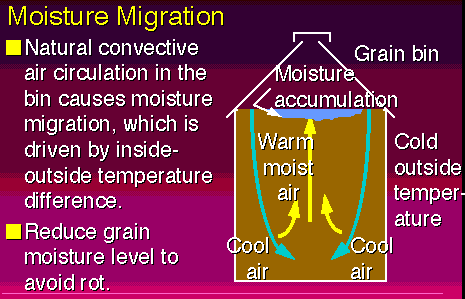
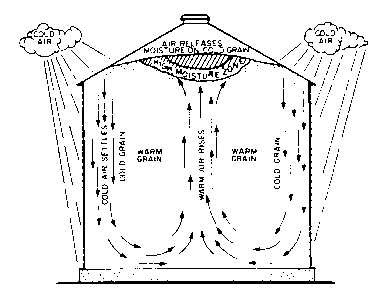
Minimize moisture migration, storage diseases, and insect
damage
Dry to 13% for safe, long term storage
Closed loop drying system
-
Short bins: wet grain is dried
-
Tall bins: dry grain is stored
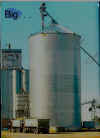




Shiver drying system
-
Drying bin - Corn dried to 15 % moisture with forced,
heated air
-
Storage bins - Corn dried from 15 % moisture down to 13%
-
Corn is augured from drying bins to storage bins
automatically
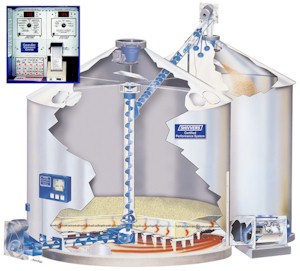
Low temperature drying system
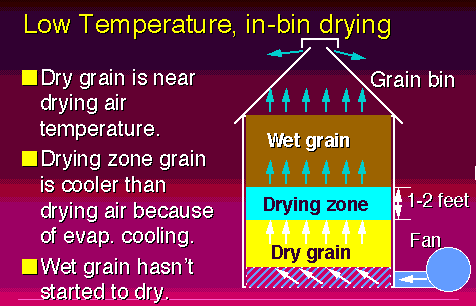
Temperatures at which to dry corn
-
Continuous flow = 180 to 220 F
-
Corn to be used for wet milling, not exceed 140 F
-
Corn used for dry milling, not exceed 110 to 120 F
-
High temperatures reduce test weight, discolor kernels,
denature protein, gelatinize starch and increase stress cracks
Recommendations for grain drying air flow by region:
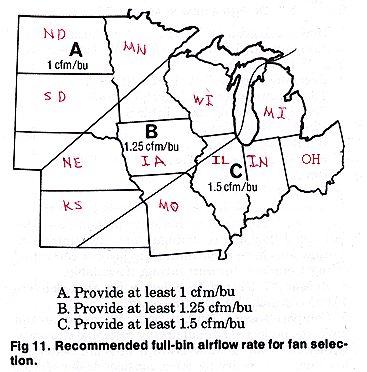
The eastern and southern portions of the region need higher air flows because of higher humidities and somewhat warmer temperatures at harvest.
Hazards of Grain Drying Systems
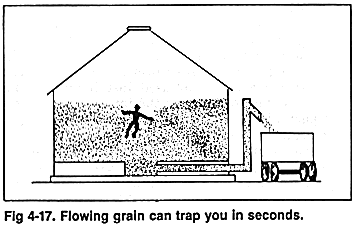
(From MWPS-13 Grain Drying, Handling and Storage Handbook, 1987.)
A 200-lb human with a density of approximately that of water has a volume
of approximately:
200 lb / (62.4 lb/cu.ft.) = 3.2 cu.ft. If the grain flow out of the bin is
1500 bu per hour, that is equivalent to 1500 bu x 1.244 cu ft/bu x 1/3600
hr/s = 0.518 cu ft/sec. So the human, if he/she is at the center of grain
flow, will be buried in the grain in 3.2 cu ft/(0.518 cu ft/s) = 6.17
seconds.
Storage requirements - shell corn
Length of time depends upon temperature and humidity of
grain
Temperature:
-
Keep grain temp close to outside air temp
-
Cool with fans in late fall
-
Warm with fans in early spring
Remove fines
-
Worst problem in stored grain
-
Inhibit air flow and cause heating
-
Easiest for insects and diseases to attack
Temporary Grain Storage Tips
Picking sites that are elevated and have good drainage is the key to
storing grain on the ground. The risk of crop loss is higher when grain is
stored on the ground than in bins, so ground piles should be considered
short-term storage and monitored frequently.
The success of storing grain on the ground depends on a combination of
variables that can be controlled, such as site preparation, storage design,
use of aeration and storage management, and factors that can't, such as the
weather.
Advice for preventing crop loss:
- Select a site that's elevated, has good drainage and is large enough
to accommodate the volume of crop being stored and has roughly 130 feet
of turnaround space for trucks dropping off the grain.
- Prepare a pad for the grain to rest on by mixing lime, fly ash or
cement in the soil to prevent soil moisture from wetting the grain. Make
a concrete or asphalt pad if the site will be used for several years.
- Create a crown in the middle of the pad with a gradual slope away
from the center for water drainage. Also make sure the area around the
pad drains well.
- Run piles north and south to allow the sun to dry the sloping sides.
- Build a retaining wall to increase storage capacity.
- Place only cool (less than 60 F), dry, clean grain on the ground.
Maximize pile size to reduce the ratio of grain on the surface, which is
exposed to potential weather damage, to the total grain volume.
- Build the pile uniformly for maximum grain surface slope and avoid
creating hills, valleys, folds and crevices that will collect water.
- Form the pile quickly and cover it immediately to minimize its
exposure to moisture, wind and birds.
- Install an aeration system to cool the grain so its temperature is
uniform and equal to the average outdoor temperature. Cool temperatures
minimize mold growth, limit moisture movement and control insects.
- Check grain temperatures and moisture content at several locations
in the pile every two to three weeks.
- Frequently check the pile's cover for rodent-caused perforations,
damage from wind or ice, worn spots and vandalism, and make repairs.
- Inspect retaining walls for separation or movement at the
connections and deterioration of the materials in the walls. Also make
sure wall anchors still are holding.
- When removing the grain, load it from the center of the pile to
prevent uneven pressure on the retaining wall.
- Try to separate spoiled grain from the pile to limit the amount of
grain that needs cleaning, drying and blending with other grain stored
in outdoor piles.
Producers also have alternatives to piling grain on the ground, such as
storing grain in empty barns and pole buildings used for machinery storage.
Here are some tips when using these buildings:
- Make sure the site is well-drained.
- Strengthen buildings to support the pressure of the stored grain.
Most buildings were not designed or built to withstand any pressure on
the walls.
- Check with the building's manufacturer on how deep to fill the
structure with grain.
Special Grades of Corn:
-
Flint
-
Flint and dent
-
Weevily
-
Waxy
Corn is traded on the basis of US No. 2
-
No premiums for US No. 1
-
Docked if below US No. 2
CORN GRADING: Grade Requirements for Corn
| |
|
Maximum limit of
damaged kernels |
| Grade |
Minimum test weight per bushel |
Total damaged kernels |
Heat damaged kernels |
Broken corn and foreign materials |
| |
pounds |
percent |
percent |
percent |
| |
|
|
|
|
| U.S. Number 1 |
56.0 |
3.0 |
0.1 |
2.0 |
| U.S. Number 2 |
54.0 |
5.0 |
0.2 |
3.0 |
| U.S. Number 3 |
52.0 |
7.0 |
0.5 |
4.0 |
| U.S. Number 4 |
49.0 |
10.0 |
1.0 |
5.0 |
| U.S. Number 5 |
46.0 |
15.0 |
3.0 |
7.0 |
| U.S. sample grade
U.S. sample
grade shall be corn which:
Does not meet the requirements for the grades U.S. Numbers 1,
2, 3, 4, or 5; or In a 1,000 gram sample, contain 8 or
more stones which have an aggregated weight in excess of 0.20
percent of the sample weight, 2 or more pieces of glass, 3 or more
crotalaria seeds (Crotalaria ssp.), 2 or more castor beans (Ricinus
communis), 8 or more cockleburs, 4 or more particles of an unknown
foreign substance(s), or a commonly recognized harmful or toxic
substance(s), or animal filth in excess of 0.20 percent; or has a
musty, sour, or commercially objectionable foreign odor; or is
heating or otherwise of distinctly low quality.
|
Further Reading
Grain Drying and Storage of Damp Grain
University of Manitoba
MidWest Plan Service - Available from
AgriculturalEngineering Plan Service, 219A L.W.Chase Hall,
University of Nebraska, 68583-0727 phone 402-472-6718. There
is a charge for the publications and a fee for handling and
postage.
-
MWPS-13 Grain Drying, Handling and
Storage Handbook
-
AED-20 Managing Dry Grain in Storage
-
MWPS-29 Dry Grain Aeration Systems
Design Handbook
Emergency/Temporary Grain Storage
Considerations
Strategies for Utilizing Commodity Loan and LDP
Provisions
Grain Storage: Value, Costs, and Returns
Prepare Grain Bins and Equipment for Harvest
Initial Condition Determines Quality of Stored Grain
Grain Cleaners and Spreaders
Management - The Key to Maintaining Stored Grain Quality
Using Existing Buildings for Temporary Grain Storage
Insect Pest Management in Farm-Stored Grain
Temporary/Emergency Grain Storage Options
Computations on Grain Stored in Various Configurations
Schematic Plans and Software
Schematic Plan of a 6' by 8' Portable Bulkhead Wall
Schematic Plan of an 8' by 8' Portable Bulkhead Wall
Engineering Grain Storage and Aeration
Systems
Purdue - Dryeration & Bin Cooling Systems For Grain
Purdue - Fan Sizing and Application for Bin
Drying/Cooling of Grain
NDSU - Grain Drying, Part I - Introduction
NDSU - Grain Drying, Part II - Types of Dryers and
Drying
NDSU - Grain Drying, Part III - Energy, Quality Fire,
Moisture and Fans
NDSU - Grain Drying, Part IV - Heaters, Costs, Safety
and Managing Stored Grain
Aeration Management
General Grain Quality and Storage
Information
Purdue - Post Harvest Grain Quality - Stored Product
Protection Program - Home page
Stored Grain Pest Management
ISU - Indian Meal Moth
U of MN - Stored-product Insects and Biological Control
Agents
Ohio St - Confused and Red Flour Beetles HYG-2087-97
Ohio St - Sawtoothed and Merchant Grain Beetles
HYG-2086-97
Ohio St - Granary and Rice Weevils HYG-2088-97
Uses and Quality
USDA Grading Standards and Moisture Conversion Table for
Corn Purdue University AY-225
Popcorn Production and Marketing National Corn
Handbook - 5
Sweet Corn Production National Corn Handbook - 43
Other publications
Aflatoxins and Other Mycotoxins National Corn
Handbook - 52
Temporary Grain Storage North Dakota State
University AE-84
http://www.agcom.purdue.edu/AgCom/Pubs/grain.htm
Gib Ear Rot of Corn
PDF
Costs of Drying High-Moisture Corn
PDF
Shifting from Corn Drying to Corn Storage
PDF
Why Is Stored Corn Deteriorating Prematurely?
PDF
Grain Storage Problems Are Increasing the Dangers to Farm
Operators (revised)
PDF
Drying Wheat to Prevent Spoilage and Sprouting
PDF
Integrating Temperature and Pest Management for Successful
Grain Storage
PDF
Grain Mite Infestation: Prevention and Control
PDF
Proper Use of Moisture Meters
PDF
Optimizing Dryer Operations
PDF
Rewarming "Supercold" Grain
PDF
Blue Eye in Corn
PDF
Last Minute Grain Dryer Checks
PDF
Slow Versus Fast Low-Temperature Bin Drying of Corn
PDF
Keeping Cold Grain Cold
PDF
Head Scab of Wheat and Vomitoxin
PDF
Quality Grain Needs TLC
PDF
Vomitoxin in Feed Wheat for Hogs
PDF
Harvesting, Drying, and Storing Frost-Damaged Corn and
Soybeans
PDF
Cob Rot Damaged Corn
PDF
Ear Corn Drying, Storage and Handling
PDF